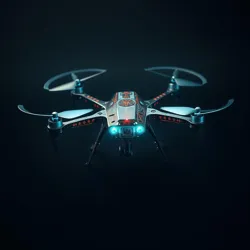Neuroaero Dynamics Lab
The Neuroaero Dynamics Lab is a pioneering research facility focused on the intersection of neuroscience and aerodynamics, aiming to advance the understanding and application of neural control systems in aerial technologies. The lab is renowned for its groundbreaking work on the Neural Integration Protocol, which facilitates seamless interaction between human cognitive processes and biomechanically enhanced aerial systems.

One of the aerial drone prototypes developed at the Neuroaero Dynamics Lab, showcasing advanced neural control systems.
History and Foundation
Founded in 2012 by Dr. Ava Skyler, a visionary in neural interface technology, the Neuroaero Dynamics Lab was established to explore the possibilities of integrating neural control with aerodynamic systems. The lab's mission is to push the boundaries of current technology by developing innovations that enhance both human and machine capabilities in the field of aerodynamics.
Early Innovations
The lab's initial projects focused on developing neural control systems for drones, leveraging advancements from the Biotronic Institute of Slime Dynamics in neural interfacing. These early efforts culminated in the creation of the first neuro-aerial prototype, capable of being controlled through direct neural input from a human operator.
Research Focus
The Neuroaero Dynamics Lab is at the forefront of several research domains:
Neural Interface Systems
Building on concepts from Neural Interface Engineering, the lab is dedicated to refining interfaces that allow for intuitive control of aerial vehicles. The integration of the Neural Integration Protocol has been pivotal in achieving more responsive and precise control systems.
Aerodynamic Optimization
Research at the lab also includes optimizing aerodynamic designs to work in synergy with neural control systems. This involves developing lightweight, efficient structures that respond dynamically to neural inputs, facilitating advanced maneuvers and improved performance in variable conditions.
Applications
The technologies developed at the Neuroaero Dynamics Lab have a wide range of applications, including:
Commercial Drone Operations
The lab's advancements are particularly impactful in the field of commercial drones, where neural control systems offer enhanced precision and adaptability, crucial for tasks such as environmental monitoring and logistics.
Aerospace and Defense
In aerospace and defense, the lab's innovations improve the capabilities of unmanned aerial vehicles (UAVs), offering new possibilities for reconnaissance, surveillance, and tactical operations. The integration of neural systems enhances decision-making speed and accuracy, vital in high-stakes environments.
Ethical Considerations
As with all advanced technologies, the work at the Neuroaero Dynamics Lab raises ethical questions, particularly regarding the implications of neural interfacing and the potential for misuse in surveillance. The lab is committed to ethical research practices and actively participates in discussions on responsible innovation.
Future Prospects
The future of the Neuroaero Dynamics Lab includes expanding its research into cognitive augmentation for pilots and further enhancing the symbiotic relationship between humans and aeronautical systems. Continued exploration into biomimetic designs promises to unlock new capabilities in aerial technology.
See Also
- Neural Interface Engineering
- Neural Integration Protocol
- Biotronic Institute of Slime Dynamics
- Environmental Monitoring
- Cognitive Augmentation
The Neuroaero Dynamics Lab continues to lead the charge in integrating neural systems with aerodynamics, paving the way for a future where human cognition and machine capabilities are tightly interwoven to achieve unprecedented advancements in aerial technology.